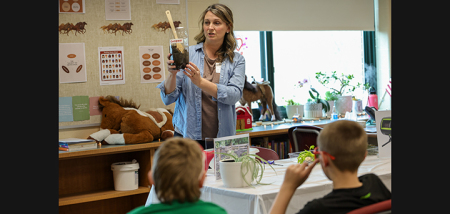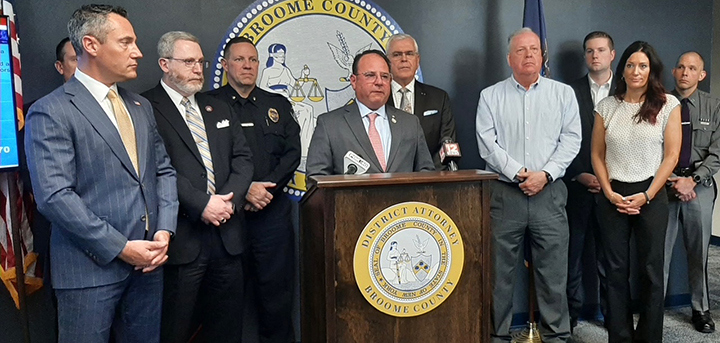Middle School Holds Talk On Bullying, Sexting
Published:
January 29th, 2016
By:
Ashley Babbitt
By Ashley Babbitt
Sun Managing Editor
ababbitt@evesun.com
NORWICH – An informational discussion for parents was held last week at the Norwich Middle School, where the school’s bullying prevention program was explained and a New York State Police Investigator discussed the dangers of cyberbullying and sexting.
The program is a research-based program that deals with bullying at school-wide, classroom, individual and community levels. It’s focused on changing the norms and restructuring the school setting.
Norwich Middle School Principal Scott Ryan explained to the parents and students in attendance the definition of bullying. According to Dan Olweus, the program’s founder: “Bullying is when someone repeatedly and on purpose says or does mean or hurtful things to another person who has a hard time defending himself or herself.”
“A recent survey administered to students in grades 6-8 suggests that 17 percent perceive they have been targets of bullying 2-3 times a month. The national comparison hovers around 18 percent inclusive of boys and girls,” said Ryan.
Bullying involves three components: aggressive behavior, a pattern of behavior repeated over time, and an imbalance of power or strength.
Ryan said, “Not everything is bullying, which is why we name it; define it. We then promote students to be upstanders, with the courage to stand up and intervene if they see bullying taking place.”
“The K-12 OLWEUS program that NCSD has adopted places its emphasis on the bystander and teaches students skills to do this. The same survey revealed over 50 percent of students already do this. Our language focuses on target, aggressor and shifting from a bystander to an upstander – someone who has the skills and courage to address conflict that could be or could lead to bullying,” said Ryan.
NMS has four rules regarding bullying: “We will not bully others;” “We will try to help students who are bullied;” “We will try to include students who are left out;” “If we know that somebody is being bullied, we will tell an adult at school and an adult at home.”
A poster stating these rules is in each classroom of the school.
The OLWEUS program has three-year implementation plan. In the 2015-16 school year, the goal is for the school-wide understanding of the terms “target,” “aggressor,” and “bullying.” There will be in-house communication material, and teacher training for intervening.
In the 2016-17 school year, there will be class meetings on the topic one to two times per month. There will be contact people for grades 6-8.
By 2018, the program will be fully implemented with class meetings once per week.
The school has formed two committees, one being a teacher committee and the other being a school interest committee. The teachers and staff will be trained to use the program and how to intervene. It was said the aggressor will be given consequences, the target will be supported, and there will be a follow-up with both students and parents.
Ryan offered options to parents regarding what they can do if they believe their child is a target of bullying behavior.
“Share your concerns with your child’s teacher or someone on the NMS OLWEUS Committee,” said Ryan. “Talk with them and listen carefully. Support them, don’t blame them. Try to find out more about your child’s school life in general: friends at school, who they sit with at lunch, or anyone that they don’t like and why. Encourage them to find interests and hobbies both in and out of school.”
Ryan then went on to explain what a parent can do if their child is the aggressor in the situation.
“Make it clear that you are against bullying and that it is not okay,” said Ryan. “Develop clear rules for behavior within your family: praise for positive behavior and loss of privilege when rules are broke. Spend time with your child and get to know their friends. Enroll them in clubs that appeal to your child’s talents. Share your concerns with your child’s teacher or someone on the OLWEUS Committee.”
In the middle of the presentation, Ryan asked random students in attendance to state something they had learned thus far.
A young student said, “To not bully.”
One parent said, “To be proactive.” Another parent discussed accountability, and that it’s important that parents make sure they know what’s going on. She went on to say that if your child is the aggressor in a situation, to hold yourself as a parent accountable and take the steps to rectify the situation.
“I believe this school is safe,” said Ryan. “Does that mean things like this don’t happen on a daily basis? Not at all.”
“I can’t tell you how often we get calls,” Ryan added. “Then we must determine if it’s really bullying. What we do know, is that the child wants to see it stopped.”
“And consequences for bullying does not mean taking them outside and hanging them from the flagpole,” said Ryan. “It does not necessarily mean a three-day suspension. This program will help us address the issue and hope to minimize it. We now have a dedicated team for this.”
Ryan said one of the most important aspects is to teach the students the skills to deal with these issues that will carry on with them for the remainder of their lives, not solely in middle school.
“We need to imbed social etiquette,” said Ryan. “It’s not just teachers talking to kids. We need them to be forthcoming. If we don’t know, we can’t help.”
“Help is sometimes giving them the skills to handle it themselves,” said Ryan with regard to the program’s push for upstanders rather than bystanders to bullying.
Ryan confirmed that no students from NMS have been petitioned to Family Court for bullying-related incidents (students that are middle-school age would not go through the criminal court system, but Family Court).
The discussion then moved to the topic of electronic devices and the role they play with regard to bullying.
“Cyberbullying is a bi-product of the technology generation,” said Ryan. “Cell phones don’t come with ‘how to parent a teenage social media user.’”
Said Ryan, “Facebook, Twitter, Snapchat, Instagram, Yik Yak … I don’t have any of those, but I do know the dangers of them. The student’s electronic device goes into their bedroom at night, and that’s when the danger begins.”
It was suggested that parents make their children leave their phones in a common area over night to charge, rather than allowing them to take it into their bedroom.
Investigator Kane of the NYS Trooper’s Computer Crimes Unit then spoke more on cyberbulling and sexting dangers and consequences.
Kane said that cyberbulling can not only take place on cell phones, but also on Kindles and gaming systems.
“A parent simply viewing and monitoring one system doesn’t show the whole picture to the parent,” said Kane. He encouraged parents to have their children only play things such as Xbox Live with friends rather than strangers. “I play, and what gets said to me as an adult is insane,” Kane said.
“You as a parent wouldn’t call and invite a bully to join your child in their bedroom after 9:00 at night. If you allow your child to have access to electronic devices and social media after bed time, you are doing exactly that,” said Kane.
With regard to that, Ryan added, “I offer this as one easy step parents can take that can minimize the negative communications that can and will occur if children are left their own decision making.”
Kane stressed how quickly everything moves on social media. Photos reach a wider audience and more importantly, he said, follows the children home.
“There is harassment about images, mean texts, photoshopping faces or objects onto pictures of other students, fake profiles, rumors and gossip, embarrassing photos, and threatening comments,” said Kane.
Kane added, “You, the parents, have the ability to control their devices. Law enforcement officers, school officials can’t. Talk with them about the risks at every age. Talk to them about sexting. Know who is on their friends list. Have their username and password.”
Kane said that a cyberbullying victim may act nervous when their phone dings, or they say they don’t want to go to school. A parent can encourage the child to block the cyber bully, and set up a new account.
Kane added that a cyber bully’s behavior involves quickly switching from what was on their phone’s screen, they’re on their computer or device at all hours, or have multiple accounts.
Nationally, 20 percent of teens have sent nude photos.
“An 11-year-old [from a different county] sent nude photos of herself using her Nintendo DS,” said Kane.
Kane said that nationwide, 48 percent of teens say they have received nude or sexually suggestive messages.
“The moment it is online or out there, you have lost all control of that content,” said Kane.
“Everyday [not at the NMS] middle school and high school students are being arrested for possessing and disseminating child pornography,” said Kane. He explained that students having these photos on their phones is indeed a crime. Sharing a nude photo is disseminating child pornography, and the recipient is then in possession of child porn.
Kane explained that ‘revenge porn’ is now common, which is when a breakup goes bad and one party sends nude photos of the ex to friends in school, which he said can be used as a method of bullying.
“At the end of the day,” said Ryan, “the disciplinary responsibility of the school begins if and when the negative interaction via social media causes a disruption to the school day. The responsibility lies in the hands of the parent/guardian. Know who your kids are talking to, who is part of their friends list, and what sites they have access to. Parents need to educate themselves on what teens are using to communicate and also how to monitor this use. We will be adding information to our website that addresses steps parents can take to monitor use of electronic devices soon.”
Author: Ashley Babbitt - More From This Author
Comments








